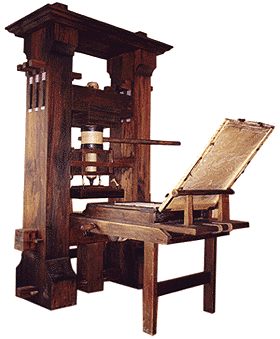What is Johannes Gutenberg credited with?
Inventing the technology of printing with movable type.
Post a photo of the Gutenberg Press.
How did the printing press work?
Ink was rolled over the surface of movable hand-set block letters held within a wooden form.
What motivated Gutenberg to find a better way of creating books?
Watching goldsmiths and jewelers performing their craft, and a love for reading.
Why did Gutenberg experiment with metal type versus wood type?
metal type could be reproduced more quickly once a single mold could be made.
Post an example of movable type in a type case.
What is moveable type?
the system of printing and typography that uses movable components to reproduce the elements of a document.
What is a matrix?
an object upon which a design has been formed and which is then used to make an impression on a piece of paper, thus creating a print.
What ink did Gutenberg develop that he used specifically for the printing press?
oil based ink.
What is paper made from? Where did paper originate?
Wood pulp. Created in 105AD by Tsai Lun.
What is a "substrate"?
the base material onto which e.g. images will be printed and to be laminated as per the packing specification required for the product.
Who did Gutenberg seek to help with the invention of the press? Close to the end of the 5 years, what happened?
John Fust and Peter Schoffer. At teh end of the 5 years, Fust sued Gutenberg and he lost the press, tools, and all 180 bibles.
What was the first book he printed?
The bible.Post an example of this book.
How did the Gutenberg Press impact communication?
Perfected script and made it easier to read. Books made more rapidly. Current information could be shared locally and around the world.
Who introduced the printing press to England?
William Caxton.
What was the early form of newspapers?
Trade newsletters.
When was the first news weekly published? What was it called?
1704. The Boston Letter.
What kind of press was built in the US in the mid 1800s?
Steam powered rotary press.
Post an example of a 1930s printing press.
By the late 1930s, presses had increased in efficiency and were capable of 2,500 to 3,500 impressions per hour. What is meant by "impression"?
People seeing the product.
Which printing process is the Gutenberg press an example of? Briefly describe the process?
Relief printing. Movable type is placed into the press. Ink is spread onto the type. Paper is placed on top. The press applies the direct pressure needed to transfer the ink to paper.
Post an example of an intaglio press.
What is intaglio printing and how is ink transferred?
Image area is etched into the plate surface to hold the ink. the press applies pressure to transfer the ink to the paper.
Post an example of a screen (porous) printing press.
What is porous printing and how is ink transferred?
basic stencil process. Ink is forced through open mesh areas.
Post an example of a lithography printing press.
What is lithography and how is ink transferred?
Printing from a flat surface. greasy ink/crayon is used to create art. water is applied. the ink accepts the greasy parts and not the watery parts.
Post an example of a offset lithography printing press.
What variation of lithography is used by the commercial printing industry today?
offset lithography.
How do printing presses used today compare to the Gutenberg Press?
The are faster and more complex.
Describe four-color process printing using CMYK?
a subtractive color model, used in color printing, and is also used to describe the printing process itself.








No comments:
Post a Comment